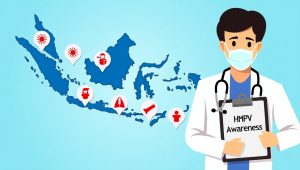
Human Metapneumovirus (HMPV) is a respiratory virus that remains largely under the radar despite its growing significance in global health. While much attention has been given to viruses like influenza and COVID-19, HMPV has quietly caused widespread respiratory illness, particularly among vulnerable populations. In Indonesia, where respiratory diseases are a major public health concern, the overlooked nature of HMPV presents a unique challenge to the healthcare system.
What is HMPV?
HMPV is a virus belonging to the Paramyxoviridae family, which includes other respiratory pathogens such as respiratory syncytial virus (RSV) and parainfluenza viruses. First identified in 2001, HMPV has likely been circulating undetected for decades. It is transmitted through respiratory droplets, direct contact with infected individuals, or touching contaminated surfaces.
The virus typically causes respiratory symptoms that range from mild to severe, including:
- Fever
- Cough
- Sore throat
- Nasal congestion
- Shortness of breath
In healthy individuals, these symptoms often resolve without complications. However, in vulnerable populations—such as infants, the elderly, and those with weakened immune systems—HMPV can lead to severe conditions like pneumonia and bronchiolitis.
Why is HMPV Overlooked in Indonesia?
HMPV is often overshadowed by other, more well-known respiratory illnesses. In Indonesia, the lack of awareness about HMPV among both the public and healthcare providers contributes to its underdiagnosis. The virus shares symptoms with other respiratory infections, making it difficult to distinguish without specific diagnostic tests.
Indonesia’s healthcare system faces additional challenges that exacerbate the issue. Limited access to advanced diagnostic tools, especially in rural areas, means that many cases of HMPV go undetected. Moreover, the healthcare system is already burdened by high rates of other respiratory diseases, such as tuberculosis, influenza, and COVID-19, leaving little room to address emerging threats like HMPV.
Vulnerable Populations at Risk
Certain groups in Indonesia are at higher risk of severe illness from HMPV, including:
- Infants and Young Children: Infants under six months old are particularly vulnerable due to their developing immune systems. HMPV can cause severe respiratory distress in this age group.
- Elderly Adults: Older adults often have weakened immune systems and pre-existing health conditions, such as asthma or chronic obstructive pulmonary disease (COPD), which increase their susceptibility to HMPV complications.
- Immunocompromised Individuals: People with weakened immune systems, such as those undergoing chemotherapy or living with HIV, face a higher risk of severe outcomes from HMPV infection.
Addressing the Threat of HMPV
To address the overlooked threat of HMPV in Indonesia, a multi-faceted approach is required:
- Raising Awareness: Public health campaigns should educate the public and healthcare providers about HMPV, its symptoms, and the importance of early detection.
- Improving Diagnostic Capabilities: Expanding access to diagnostic tests, such as polymerase chain reaction (PCR) tests, is essential for accurate identification of HMPV cases.
- Strengthening Healthcare Infrastructure: Hospitals and clinics must be equipped to handle severe respiratory cases, particularly in rural and underserved areas. This includes ensuring access to oxygen therapy and ventilators.
- Promoting Preventive Measures: Encouraging good hygiene practices, such as handwashing and wearing masks, can help reduce the spread of HMPV.
Conclusion
HMPV is a significant yet overlooked respiratory virus that poses a growing threat to public health in Indonesia